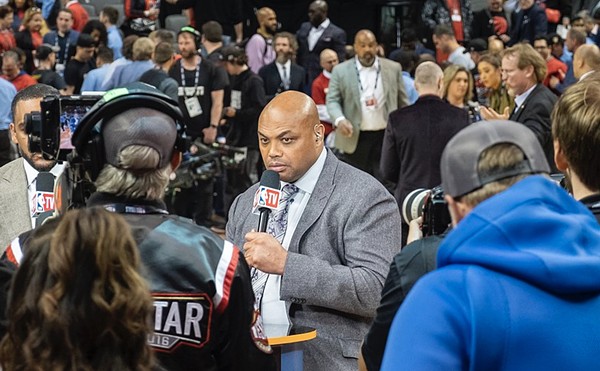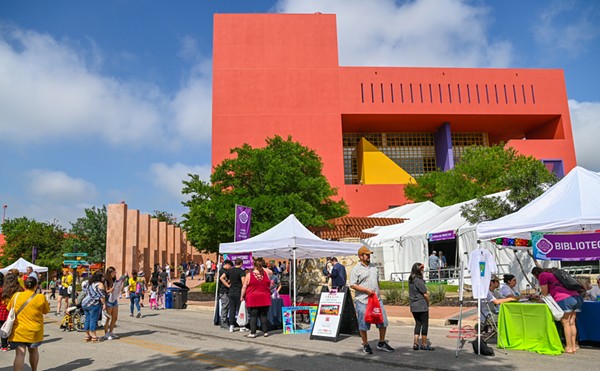Some things never change. The hypocrisy of powerful figures. The struggle between liberty and authority. And Shakespeare plays set in clever places. Think Romeo and Juliet in Baghdad, Macbeth in the White House, or The Tempest on the moon.
The production of Measure for Measure currently on at St Philip’s College sets the play in a pre-Katrina world of Mardi Gras and corrupt politicians. Director Vincent Hardy substitutes a Mayor for the Duke and replaces each of Shakespeare’s references to Vienna with New Orleans.
As settings go, this is a promising choice. New Orleans provides the licentious yet religious backdrop that Shakespeare’s play demands. The city has famously risqué festivals, Catholic and Voodoo spiritual roots, a mixture of racial and ethnic backgrounds, and an often racist, corrupt criminal-justice system. New Orleans now, Hardy implies, sort of resembles Vienna then.
Why not?
Shakespeare’s darkest comedy requires just such a world of debauchery and conflict. The play’s permissive Duke (or Mayor, in this case) pretends to leave town only to disguise himself as a friar so that he can observe how his proxy, the hypocritically pious Angelo, gets along without him. (Answer: not so well. In Angelo’s first few days in office he implements a fascist regime to quash the city’s rampant prostitution, sentences Claudio to death for premarital impregnation, and subsequently offers to release him in return for sex with his sister, the nun-in-training Isabella.)
The Big Easy indeed seems an appropriately seedy setting for this tale of corruption, lust, justice, surveillance, and disguise, but with the exception of a few of Carlynn Marley’s delightful Mardi Gras costumes for the bawds, nothing onstage evokes New Orleans. Dave Morgan’s nearly symmetrical set design consists of three islands of stairs and columns, but with none of the darkness, imagination, flamboyance, or secrecy that New Orleans suggests. Ricki Kushner’s sound design includes wonderfully evocative New Orleans songs, but those largely happen before the play begins and during intermission.
Shakespeare’s play is populated with colorful bawds, including Mistress Overdone — the play’s Heidi Fleiss (in a bright, sometimes hilarious performance by Karen Rodriguez) — her employee Pompey, the city’s most prolific and mischievous pimp (played wittily by Steven Weser); and Elbow, a moronic criminal-turned-constable (played with a wonderful sense of absurdity by Reyes Rodriguez). These characters create the city’s seedy underbelly while throwing into sharp relief the ruling class’s hypocritical attempts to control sex.
These characters also allow directors an opportunity to create a physical counterpoint to Shakespeare’s words. Their movements can establish the material, sexual world that Isabella renounces, that Angelo tries to regulate, and that the Duke voyeuristically observes. Except for a brief but interesting prologue, Hardy’s direction curiously sterilizes this aspect of the action. His blocking reduces the bawds to talking heads who stand still and speak directly to the audience. The “concept” of New Orleans promises crude physicality and dynamic ensemble work, but this performance surrenders everything to the spoken word.
In Shakespeare, of course, the spoken word is nothing to shake a stick at. Isabella’s speeches are among the most eloquent and evocative considerations of justice in the canon. But in this production, the major turning points lack shape, and many of the performers lack the clarity of thought necessary to make the language work.
Ben Rosario’s Mayor is clever and thoughtful, if a bit flat in character development. Andrew Heinreich’s Angelo stands out as physically specific and truthful. James Gustafson’s Escalus is nearly incomprehensible, with his bombastic, mechanical speech patterns. Melissa Hank creates an earnest, pious, and relentlessly optimistic Isabella, but rushes her lines and fails to think through each thought.
There are several talented performers in the cast, and Hardy’s direction is largely quite competent and sensitive with regard to stage tableaus. His idea to use New Orleans is inspired — as an idea. But this production finally lacks the specificity, imagination, and attention to detail needed to make its New Orleans tangible or its considerations of justice, mercy, and the value of sexuality concrete. The New Orleans “concept” might generate a compelling essay. Indeed, Hardy’s director’s note in the program is interesting, urgent, and smart. He concludes that the play “is an argument for balance.”
But none of Shakespeare’s plays can be reduced to an argument. Measure for Measure is a particularly complex, contradictory, and nuanced piece. It certainly, in part, argues for balance, but it equally and enthusiastically manifests the excessive opposite. New Orleans can lend its excess, its images and sounds, but no concept can substitute for the detailed, beat-by-beat work needed to bring this world to life. The production of Measure for Measure at St. Philip’s College unfortunately stops at Hardy’s concept. It fails to craft a world of social forces, fraught relationships, and philosophical contradictions — a world admittedly far more difficult to achieve but also infinitely more rewarding.
Measure for Measure
8pm Fri & Sat, 2:30pm Sun
Through Nov 22
$5-10
St. Philip’s College
Watson Fine Arts Center
1801 Martin Luther King Dr.
(210) 486-2704

















